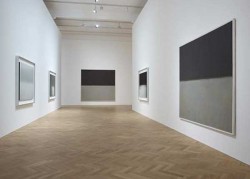Pace Gallery opens its first space in London with 8 acrylic on canvas paintings from the series of Grey Paintings of the Russian-American abstract expressionist Mark Rothko in parallel with 8 gelatin silver prints from the series Seascapes of the contemporary Japanese photographer Hiroshi Sugimoto. Until November 15th the exhibition that follows Pace’s tradition of dialogue between artists working across decades and mediums can be seen at 6, Burlington Gardens.
The first thing I noticed was the harmonical assembly of the exhibition, it was as if the pieces were made for each other, having as their common denominator the abstract, optical sensation. The dim-lightened room provoked that solemn feeling you get in churches and temples that induces contemplation. The large -format pieces of both artist functions as colour field paintings, you look up close and they absorb you. The overall split-coloured panels in both Rothko’s paintings and Sugimoto’s prints seem to take you. While staring at the horizons, the light that comes in and out of the works reflects your own self and permits a transcendental feeling, until the material becomes immaterial.
The illusion of the purely abstract works fades away when you identify images of water and rays of light in the prints and marks of the brush on the canvas that brings you back to reality. You become aware of the thin border they play in, where paintings can be more truthful than photographs and photographs more illusory than paintings. Beyond the technical distinctions of the mediums, while one captures the time of exposure the other is meant to be timeless. In this sense, it is valid to remember that these works were painted by Rothko one year before his suicide.
Both artists are alchemists of the mind, each with their different techniques but with the same posture as Renaissance masters. Even with today’s digitalisation the photographer keeps one step behind using traditional techniques to control his medium, he develops the pictures himself using a method he created. Relating to his own sense, he evolved his unique style. His formula is very much like painting, he has to mix the chemicals to get the tone of silver he wants.
To my amazement, as the exhibition followed, I came to distinguish more differences than similarities. The fluidity of the silver prints in contrast with the earthy, chunky volumes of Rothko’s paintings surprised me because I am used to Rothko’s refined cloud-like forms. The possibility of comparison is the most interesting aspect of a two-artist show. It is a museum-like exhibition for Pace gallery’s grand opening in the United Kingdom. The first private gallery exhibition of Rothko’s works in London in fifty years, unmissable.



